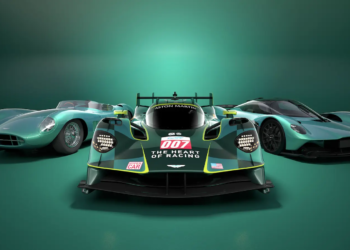Formula 1’s summer break as it transpired was not much of a break. One seismic – and often surprising – story after another landed during the four weeks’ supposed downtime. Then in the Belgian Grand Prix weekend wherein all reconvened those stories, as Scott Mitchell described it, rather spawned their own story offspring which required their own exploration.
And that of the Force India team and its new ownership was an archetype. Lawrence Stroll’s role leading the consortium means that his son Lance appearing there as a driver, from his current Williams abode, is thought a matter of time. And rumours started to swirl that this would have, possibly even before the season is out, a considerable domino effect. Or an effect of musical chairs, if we are to mix our recreational metaphors.
Robert Kubica, tester at Williams, may be promoted to race there in Stroll’s stead, ending his eight year F1 absence, said the grapevine. Esteban Ocon, consequently out at Force India, may land instead at McLaren (though he might be too tall to fit in the tub, scuppering that idea for this year at least); Stoffel Vandoorne, out at McLaren, may land at Sauber where boss Frederic Vasseur is a fan. Which in turn may mean that Marcus Ericsson would be out altogether (though Vasseur since has pooh-poohed both the Vandoorne in and Ericsson out ideas). Possibly, the grapevine continued, it all would happen as early as for the Monza round the following week.
We are in an age of relative driver line-up stability. This year there has been not a single change from the faces that made up the entry list of round one in Melbourne while in the whole of 2016 we only had Fernando Alonso sit out a single round with injury, with Vandoorne sitting in, Max Verstappen and Daniil Kvyat being swapped and Manor replacing Rio Haryanto with Ocon mid-season.
Therefore this extent of musical chairs would no doubt have come as a shock. But as with most things in F1’s historical expanse it would not begin to be a new thing. And it may not be a surprise that the tumultuous 1994 campaign was quintessential in this regard – in the course of a 16-race season no fewer than 46 drivers appeared in an F1 meeting race seat at some point. Only four of the 14 competing teams completed the full schedule with an unchanged line-up. Keeping tabs on who was actually showing up to each round was an exacting task.
Lawrence Stroll’s role leading the consortium means that his son Lance appearing there as a driver, from his current Williams abode, is thought a matter of time. And rumours started to swirl that this would have a considerable domino effect
It’s not a record total of drivers. Once again the technical inclusion of Indy 500s on the F1 schedule in the 1950s skews the figures, given Indy entry lists tend to be as long as your arm and made up almost exclusively of drivers who didn’t appear in any another F1 race. Also 1989 for example had one more driver in total at 47 but as we’re often reminded by Martin Brundle there were 39 available seats that year (and related to this plenty of 1989’s number never got beyond pre-qualifying sessions on Friday mornings); 1994 instead had 28 seats so presumably its total number of drivers in relation to the seats available – in other words a measure of the musical chairs flux – is hard to top. Plus in 1994 only one of the 46 never ran in a race itself – Andrea Montermini who was injured in a crash in practice in Spain, his only appearance of the year.
So what was going on? Well as tends to be the case when explaining extreme outcomes, in 1994 several different factors coincided.
The first one of course was tragedy. Ayrton Senna and Roland Ratzenberger died in the fateful Imola weekend and had to be replaced, and it’s less widely remembered that these were but part of a series of accidents in the early part of that year wherein drivers were injured and missed races. JJ Lehto for Benetton, Jean Alesi for Ferrari and Pedro Lamy for Lotus all had testing accidents plus there was Karl Wendlinger’s injuries sustained during Monaco qualifying which meant he missed the rest of the year.
There was the occasional slightly more odd knock-on impact of these, most notably Nigel Mansell being parachuted into Williams for four rounds that did not clash with his Indycar commitments, a combined consequence apparently of Williams’ engine supplier Renault not having massive faith Damon Hill’s ability to lead the team and Bernie Ecclestone’s desire to reinject Mansell’s star quality into an F1 recently deprived of Senna and Alain Prost.
There also was the matter of finances, particularly when, on the back of the tragedies mentioned, FIA president Max Mosley felt obliged to force through a series of in-season technical changes in the name of safety, many introduced almost literally overnight.
The tumultuous 1994 campaign was quintessential – in the course of a 16-race season no fewer than 46 drivers appeared in an F1 meeting race seat at some point. Only four of the 14 competing teams completed the full schedule with an unchanged line-up
Making the financial ends meet of a middling or lower F1 team was and is a tricky business at the best of times and the unforeseen additional cost of making such short notice changes and developing revised parts threw many teams into financial chaos. All squads made the end of the year though famous old Lotus did so in administration, and it and Larousse didn’t surface the following season. Ligier changed owners while Simtek lasted only a few races into 1995.
Many teams therefore scouted widely, particularly towards the year’s end, for new drivers who could bring a briefcase of cash with them. In some cases they were from very far wide – in the case of Simtek for example Mimmo Schiattarella and the inimitable Taki Inoue – who turned up in the Suzuka round and qualified mere 3.4 seconds off his team-mate David Brabham – got drives in the late rounds. “Quite how [they] managed to satisfy the FIA that they qualified for F1 superlicenes is a question which remains in the realms of speculation,” noted Alan Henry acerbically in that year’s Autocourse.
Not coincidentally, no fewer than six different drivers appeared for each for Lotus, Larousse and Simtek in 1994. With this though it’s odd perhaps that Pacific, the year’s persistent tail-ender, was one of the four teams never to change its drivers once (the others being the hardy Tyrrell, Arrows and Minardi).
Johnny Herbert though perhaps tops the lot, him appearing in three different teams in three rounds towards the season’s end. He started out at Lotus, but as mentioned the team entered administration – after the Italian round at Monza. The receivers discovered that one of the Lotus team’s few saleable assets it owned outright was its contract with Herbert, which to raise funds it sold to the highest bidder. It so happened to be the Ligier team that snapped Herbert up in advance of the European Grand Prix at Jerez, the third-last round of the season.
The unforeseen additional cost of making short notice changes threw many teams into financial chaos. Many teams therefore scouted widely for new drivers who could bring a briefcase of cash with them
Herbert did well there too, immediately impressing the team with his feedback and set-up work as well as by outpacing his incumbent team-mate Olivier Panis.
Meanwhile at Benetton things were stirring. In the race seat alongside Michael Schumacher, Lehto had struggled to recover from his early-year accident and his replacement Jos Verstappen – an inexperienced driver supposed to be the team’s tester only – was persistently outside of Schumacher’s postcode on pace. Boss Flavio Briatore after Schumi’s two race ban noticed things were getting critical in the constructors’ table versus Williams. He wanted a driver who could bag points more consistently, thus for the final two rounds he shifted Herbert into a Benetton seat.
And Briatore could do this as he had also bought the Ligier team earlier in the year (conflicts of interest are another thing not new in F1) and therefore, in rather Toro Rosso/Red Bull fashion, was able to move Herbert with a snap of his fingers. Many speculated that was the plan all along, that Ligier was in effect a Benetton B team and Herbert at Jerez was in effect being trialled.
The 1994 season had another oddity that contributed to the sizeable cast of drivers, and one that wasn’t directly related to what we’ve already described. Before 1994 there had been a single driver race ban anyone could recall – Nigel Mansell sat out the 1989 Spanish Grand Prix having missed a black flag in the previous race in Portugal (Riccardo Patrese had to sit out the 1978 United States Grand Prix too but that was due to a group of drivers strong-arming the organisers rather than official sanction).
Yet in 1994 alone three drivers served race bans: Eddie Irvine was stood down for three races early in the season after triggering a multi-car pile-up in the Brazil season-opener; Mika Hakkinen missed the Hungary race after initiating a collision at Germany’s turn one while under a suspended ban; and of course Schumacher sat out two rounds after ignoring the black flag at Silverstone. All had to be replaced. And underlining the extent that 1994 was an outlier, there’s been only a solitary race ban in the 24 years since – Romain Grosjean was kept out of the 2012 Monza race after his kamikaze pilot impression at the Belgian Grand Prix’s first turn.
Before 1994 there had been a single driver race ban anyone could recall. In 1994 alone three drivers served race bans. And underlining the extent that 1994 was an outlier, there’s been only a solitary race ban in the 24 years since
The FIA subsequently brought in a regulation, which remains active today, that teams cannot use more than four race drivers in a season. It had its effect too as in 1996 in a 22-car field just 24 drivers took part across the year, with only Minardi rotating its cast, replacing Giancarlo Fisichella first briefly with Tarso Marques and then later with the famous ‘Johnny Carwash’ Giovanni Lavaggi.
It also, seemingly inadvertently, put Sauber into a bind the following year. The team started the 1997 campaign with Herbert alongside Nicola Larini, the long-time Ferrari test driver coming seemingly with the supply of Ferrari engines. Larini didn’t like his role in the squad and was replaced a few rounds in by Gianni Morbidelli. He though broke his arm in a test prior to the French round and was replaced by Sauber’s former test driver Norberto Fontana. He struggled though, as was befitting for one who had scarcely driven an F1 car recently, indeed he wanted to quit in his first appearance at Magny-Cours. But the team now, with Fontana being its fourth driver of the year, had no room to manoeuvre. He therefore had to be persisted with, indeed he had to be brought back into the seat for the final round after Morbidelli injured his arm again qualifying for the penultimate race at Suzuka.
It’s the latest reminder that everything in F1 has its consequences.






